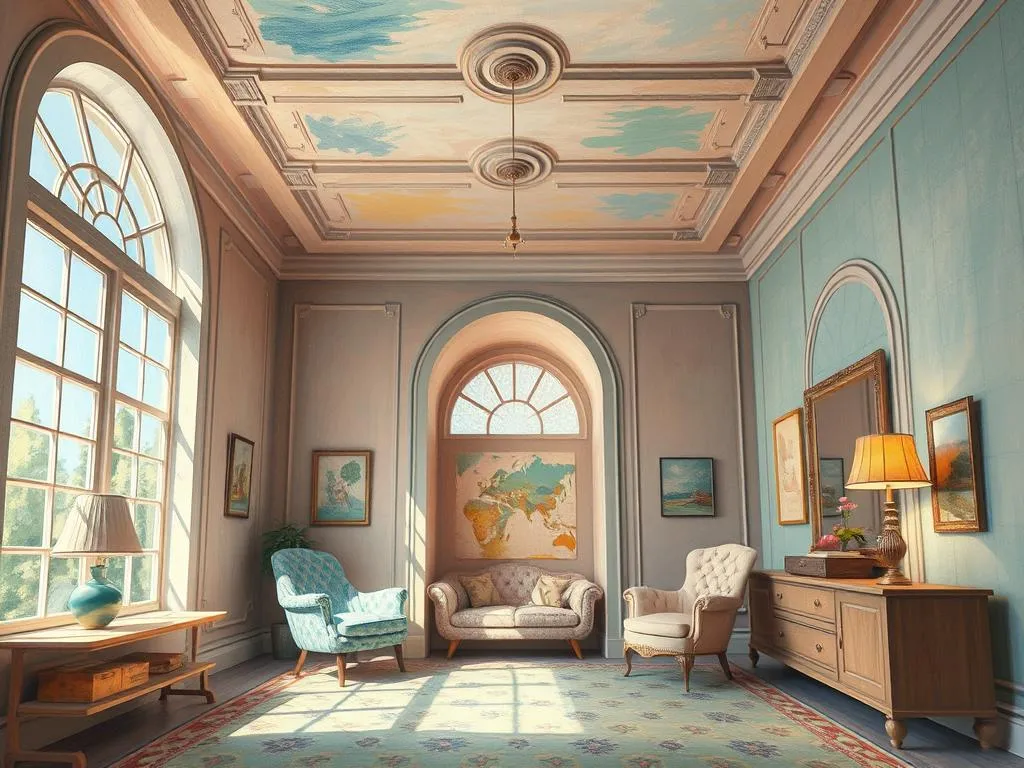
Dreams are fascinating windows into our subconscious, revealing the complexities of our thoughts, emotions, and experiences. Among the myriad of dream themes, interior architecture stands out as a compelling subject that captivates many. This type of dream often resonates with individuals seeking to understand their inner worlds, relationships, and personal growth. The relevance of such dreams lies in their ability to symbolize our evolving self and the environments we create around us, both physically and metaphorically. The exploration of interior architecture in dreams can provide profound insights into our psyche, revealing the structures we build to navigate our lives.
Symbolism and Meaning
When delving into the symbolism of interior architecture dreams, it’s essential to consider various elements within the dream. The spaces we inhabit in our dreams—be they vast, sprawling mansions or cramped, cluttered apartments—carry significant meaning. A spacious, well-lit room may symbolize clarity and openness in one’s life, suggesting a time of growth and new opportunities. Conversely, a dark, confined space might reflect feelings of anxiety, restriction, or emotional turmoil.
The furniture within these spaces also plays a critical role in the dream’s interpretation. For instance, a beautifully arranged living room can signify harmony in personal relationships, while disorganized or broken furniture may point toward unresolved conflicts or dissatisfaction in one’s social life. Similarly, specific items can have unique meanings; a sturdy table might represent stability and community, while a lonely chair may evoke feelings of isolation.
Colors and textures are additional elements that can influence the dream’s overall message. Bright, vibrant hues often convey positivity and energy, while muted or dark colors may indicate confusion or depression. The textures—smooth, rough, inviting, or abrasive—can also symbolize emotional states or experiences; for example, a soft, inviting couch might signify comfort and safety, whereas a cold, hard floor could reflect feelings of vulnerability or exposure.
From a psychological perspective, these dreams can also represent the construction and deconstruction of the self. The act of rearranging or altering spaces in a dream can indicate personal transformation or a desire to change certain aspects of one’s life. Dreaming of renovating a room may suggest that you are contemplating significant changes, whether in your career, relationships, or self-identity.
Additionally, the presence of architectural elements such as doors, windows, and staircases can further enrich the dream’s meaning. Doors often symbolize new opportunities or transitions, windows may represent insights or perspectives, and staircases can indicate personal progress or challenges. Each of these elements invites reflection on the various pathways we navigate in life, urging us to consider where we may be headed or what we might need to let go of.
Key Scenarios and Variations
Understanding the nuances of interior architecture dreams requires examining specific scenarios that commonly occur within them. One prevalent variation involves the dreamer discovering hidden rooms or spaces within a familiar environment. This scenario can indicate the unveiling of repressed emotions or aspects of oneself that have long been ignored. The discovery of these hidden areas can be a profound revelation, suggesting that the dreamer is ready to confront and integrate these hidden parts into their life.
Another common scenario is the feeling of being lost within a labyrinthine building. This dream can symbolize confusion or uncertainty in one’s waking life, particularly when dealing with complex situations or relationships. The intricate layout of the building may reflect the dreamer’s struggle to find clarity or direction amidst chaos. The sensation of being trapped or unable to find an exit can highlight feelings of being overwhelmed or stuck in a particular life situation.
Conversely, dreams that involve redesigning or decorating a space can represent a desire for change and self-improvement. This scenario often signifies a proactive approach to personal growth, suggesting that the dreamer is actively seeking to enhance their life circumstances. The specifics of the redesign—such as the choice of colors, furniture, and layout—can offer additional insights into the dreamer’s aspirations and emotional state.
Another fascinating variation is the dream of renovating an old or neglected building. This can symbolize the process of healing and reformation. It suggests that the dreamer is engaging in self-reflection, working to rebuild or restore areas of their life that feel outdated or unfulfilled. This dream scenario highlights the importance of nurturing and revitalizing one’s emotional and mental well-being.
Additionally, encountering familiar versus unfamiliar architectural settings can influence interpretation. A familiar place may evoke nostalgia or unresolved issues from the past, while an unfamiliar space could represent new experiences or challenges on the horizon. The emotional response to these spaces—whether comforting or unsettling—also plays a significant role in determining the dream’s message.
Real-Life Connections and Takeaways
Connecting the themes of interior architecture dreams to real-life situations can offer valuable insights and opportunities for self-reflection. One of the first steps in this process is to consider the emotional tone of the dream. Reflecting on your feelings during the dream can provide clues about your current emotional state and the areas of your life that may require attention.
For example, if you felt joy and comfort in a spacious, beautifully decorated room, it may indicate that you are in a positive phase of your life, filled with abundance and opportunities. In contrast, if the dream left you feeling anxious or trapped, it might signal that certain aspects of your life are causing stress or discomfort, urging you to confront and address these issues.
Another practical approach is to evaluate the spaces you inhabit in your waking life. Are your physical environments—your home, workplace, or social circles—reflecting your inner state? Consider whether you’re surrounded by clutter and chaos or if your spaces are organized and inviting. The state of your physical surroundings often mirrors your mental and emotional landscape. Taking steps to declutter or redesign your environment can lead to a more harmonious state of mind.
Also, think about the relationships represented in your dream. Are there unresolved conflicts or tensions that need addressing? The presence of certain individuals in your dream may offer a hint about your emotional ties to them, whether positive or negative. Engaging in open conversations with these individuals or setting boundaries may be necessary to achieve emotional clarity.
Another key takeaway is the importance of self-discovery and the willingness to explore hidden aspects of yourself. Just as you might uncover hidden rooms in a dream, consider reflecting on parts of your personality or experiences that you may have overlooked or repressed. Journaling, meditation, or therapy can provide safe spaces for this exploration, allowing for personal growth and healing.
Lastly, envision the future you desire. As you reflect on the dreams of redesigning or renovating spaces, think about what changes you want to make in your life. What does your ideal environment look like? What steps can you take to create that space, both physically and emotionally? Setting goals and intentions based on these reflections can lead to meaningful changes in your life.
In conclusion, interior architecture dreams serve as a powerful tool for self-reflection and insight. They encourage us to examine our inner worlds, confront hidden aspects of ourselves, and seek clarity in our emotional landscapes. By exploring the rich symbolism and varying scenarios of these dreams, we can glean valuable lessons applicable to our waking lives. Embrace the opportunity to engage with your dreams, as they may hold the key to understanding your journey toward personal growth and fulfillment.







